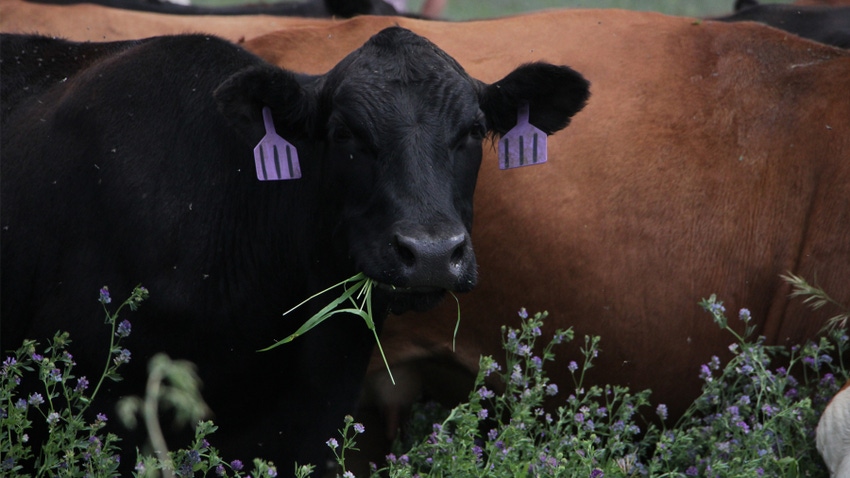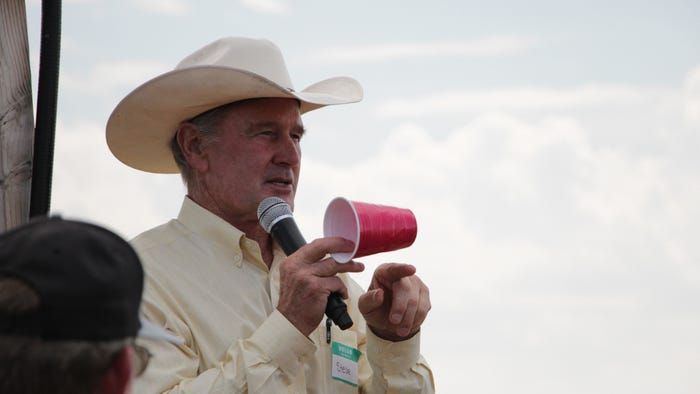
A red solo cup is a staple of picnics and tailgates, but can you use one to choose cattle?
Idaho rancher Steve Campbell, owner of Tailor Made Cattle, works with cattle producers who are looking to build their herd efficiency, improve genetics and have a more productive cattle herd. He speaks around the country on cattle fertility, minerals, profitability, linear measures and epigenetics, or how cells control gene activity without changing the DNA.
Originally, Campbell demonstrated the concept of these ideal cattle with a Styrofoam coffee cup lying on its side at speaking engagements. But one day, a forgotten cup was replaced with the iconic plastic red cup and the “red Solo cup” cow was born.
The visual represents how everything gets bigger as you go toward the back end, which indicates a higher fertility level, leading to a more productive animal.
Built differently
At the 2022 North Dakota Leopold Winner Tour in Glen Ullin in summer, Campbell said the Solo cup is an easy reminder of the main shape he looks for in cows.
“Imagine your cows are the shape of that Solo cup lying on its side, with the cow’s head being toward the smaller end of the cup,” he said. “You want females who look like they are walking downhill on flat ground.”
Campbell primarily consults with commercial ranchers who want a cow that is more fertile and costs less to feed. “Eight years ago, 80% to 90% of the people I worked with were grass finishers,” he said, adding that now 75% of his calls are from commercial cattle producers looking for cows who are easy keepers and more fertile.
The following selection criteria help identify efficient cows:
big belly
wide butt
slope from hooks to pins
“We’re hoping for a cow that can have 10 to 11 calves in a row without skipping – and this red Solo cup shape is characteristic of those cows,” he said.

LIKE A WHAT? Idaho rancher and consultant Steve Campbell said that cows resembling a sideways red Solo cup are found to be easy-keeping cattle with higher fertility rates.
The larger belly on cattle of this shape is an indicator of higher digestive capabilities. For producers trying to utilize mainly grass, ensuring high feed efficiency is a must.
Butterfat indicators
High butterfat is the second thing to look for when selecting your Solo-cup cow. “You want fine cannon bones from the knees down,” Campbell said. “The smaller in diameter the bone leads to a more tender meat, all with higher butterfat.”
Increased butterfat leads to larger calves, lower maintenance and tender meat, Campbell explained. “The higher the butterfat, the better the beef.”
More physical characteristics for high butterfat include vertical folds on the cattle hide. “The more butterfat, the more vertical folds there are in the hide, which means that hide is loose,” he said.
Further, looking for a bald udder on cows is Campbell’s final indicator of a high butterfat content. “This is actually the No. 1 indicator of butterfat, seeing that bald udder,” he said.
No matter how this beef is marketed, he said that higher butterfat leads to more tender, flavorful beef and happy customers.
High production rates
Taking the animals to a higher plane of nutrition leads to increased production rates for Solo-cup cows. “We want to look for an animal that’s thriving in the environment they’re in, because then we know she can adapt to your ranch environment,” Campbell said.
“I want to see a shiny cow that’s shed earlier than most of the herd, because then we know her gland system is adapted to her environment,” he added.
He explained that shorter animals mean a higher level of fertility, due to the hormone and growth process. “Taller animals are likely less fertile than the shorter ones, as they weren’t producing enough growth hormones like estrogen to shut off long bone growth.”
The Solo-cup cow’s wide back end also lends itself to calving ease, making it less likely to need rancher assistance. “Ranchers need cows that can get pregnant every year, raise a calf and not require a lot of external supplements or substitute feeding,” he said.
“Feedlot producers want steers who work well in a feedlot setting, but ranchers are tired of suffering through their sister’s lack of fertility on the ranch,” Campbell said of why genetic selection plays a crucial role on operations he consults with.
This ties into the concept of a cow walking downhill on level ground. “You want that slope from hooks to pins, so that the pelvis is sloped down,” he said.
For growth, watch for the “anti-fertility bone,” Campbell said. “If you’re selecting animals whose tail process raises up behind the hook bones, you’re selecting against 40% of your profit.”
Next time you’re selecting your cull cattle or choosing your replacement heifers, grab a red Solo cup for the trip. To find out more about Campbell and his consulting work, visit Tailor Made Cattle.
Read more about:
ReproductionAbout the Author(s)
You May Also Like






